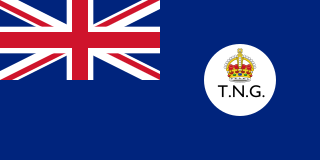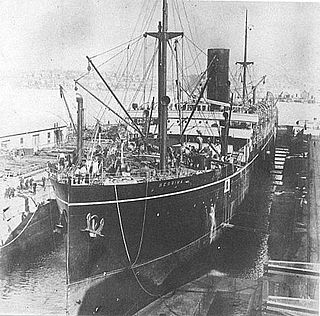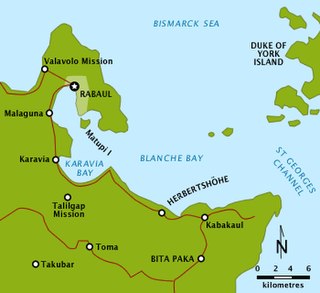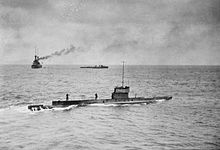
New Britain is the largest island in the Bismarck Archipelago, part of the Islands Region of Papua New Guinea. It is separated from New Guinea by a northwest corner of the Solomon Sea and from New Ireland by St. George's Channel. The main towns of New Britain are Rabaul/Kokopo and Kimbe. The island is roughly the size of Taiwan. While the island was part of German New Guinea, it was named Neupommern . In common with most of the Bismarcks it was largely formed by volcanic processes, and has active volcanoes including Ulawun, Langila, the Garbuna Group, the Sulu Range, and the volcanoes Tavurvur and Vulcan of the Rabaul caldera. A major eruption of Tavurvur in 1994 destroyed the East New Britain provincial capital of Rabaul. Most of the town still lies under metres of ash, and the capital has been moved to nearby Kokopo.

Kaiser-Wilhelmsland formed part of German New Guinea, the South Pacific protectorate of the German Empire. Named in honour of Wilhelm I, who reigned as German Emperor from 1871 to 1888, it included the northern part of present-day Papua New Guinea. From 1884 until 1920 the territory was a protectorate of the German Empire. Kaiser-Wilhelmsland, the Bismarck Archipelago, the northern Solomon Islands, the Caroline Islands, Palau, Nauru, the Northern Mariana Islands, and the Marshall Islands comprised German New Guinea.

The Australian Naval and Military Expeditionary Force (AN&MEF) was a small volunteer force of approximately 2,000 men, raised in Australia shortly after the outbreak of World War I to seize and destroy German wireless stations in German New Guinea in the south-west Pacific. The German wireless installations were ordered to be destroyed because they were used by Vizeadmiral Maximilian von Spee's East Asia Squadron of the Imperial German Navy, which threatened merchant shipping in the region. Following the capture of German possessions in the region, the AN&MEF provided occupation forces for the duration of the war. New Zealand provided a similar force for the occupation of German Samoa.

The Battle of Rabaul, also known by the Japanese as Operation R, an instigating action of the New Guinea campaign, was fought on the island of New Britain in the Australian Territory of New Guinea, from 23 January into February 1942. It was a strategically significant defeat of Allied forces by Japan in the Pacific campaign of World War II, with the Japanese invasion force quickly overwhelming the small Australian garrison, the majority of which was either killed or captured. Hostilities on the neighbouring island of New Ireland are usually considered to be part of the same battle. Rabaul was significant because of its proximity to the Japanese territory of the Caroline Islands, site of a major Imperial Japanese Navy base on Truk.

Morobe Province is a province on the northern coast of Papua New Guinea. The provincial capital and largest city is Lae. The province covers 33,705 km2, with a population of 674,810, and since the division of Southern Highlands Province in May 2012 it is the most populous province. It includes the Huon Peninsula, the Markham River, and delta, and coastal territories along the Huon Gulf. The province has nine administrative districts. At least 101 languages are spoken, including Kâte and Yabem language. English and Tok Pisin are common languages in the urban areas, and in some areas pidgin forms of German are mixed with the native language.

HMAS Warrego, named for the Warrego River, was a River-class torpedo-boat destroyer of the Royal Australian Navy (RAN). Ordered in 1909, construction of the destroyer started in England, but she was then broken down and reassembled at Cockatoo Island Dockyard in order for the Australian shipbuilding industry to gain experience in warship construction. Warrego was commissioned into the RAN in 1912, and spent her early career operating in Australian waters.

The Territory of New Guinea was an Australian-administered United Nations trust territory on the island of New Guinea from 1914 until 1975. In 1949, the Territory and the Territory of Papua were established in an administrative union by the name of the Territory of Papua and New Guinea. That administrative union was renamed as Papua New Guinea in 1971. Notwithstanding that it was part of an administrative union, the Territory of New Guinea at all times retained a distinct legal status and identity until the advent of the Independent State of Papua New Guinea.

The New Guinea campaign of the Pacific War lasted from January 1942 until the end of the war in August 1945. During the initial phase in early 1942, the Empire of Japan invaded the Territory of New Guinea on 23 January and Territory of Papua on 21 July and overran western New Guinea beginning on 29 March. During the second phase, lasting from late 1942 until the Japanese surrender, the Allies—consisting primarily of Australian forces—cleared the Japanese first from Papua, then New Guinea, and finally from the Dutch colony.

Asian and Pacific theatre of World War I consisted of various military engagements that took place on the Asian continent and on Pacific islands. They include naval battles, the Allied conquest of German colonial possessions in the Pacific Ocean and China, and an anti-Russian rebellion in Russian Turkestan and an Ottoman-supported rebellion in British Malaya. The most significant military action was the careful and well-executed Siege of Qingdao in China, but smaller actions were also fought at Bita Paka and Toma in German New Guinea.

In Australia, the outbreak of World War I was greeted with considerable enthusiasm. Even before Britain declared war on Germany on 4 August 1914, the nation pledged its support alongside other states of the British Empire and almost immediately began preparations to send forces overseas to engage in the conflict. The first campaign that Australians were involved in was in German New Guinea after a hastily raised force known as the Australian Naval and Military Expeditionary Force was dispatched in September 1914 from Australia and seized and held German possessions in the Pacific. At the same time another expeditionary force, initially consisting of 20,000 men and known as the First Australian Imperial Force (AIF), was raised for service overseas.

HMAS Berrima was a passenger liner which served in the Royal Australian Navy (RAN) during World War I as an armed merchantman and troop transport. Launched in 1913 as the P&O liner SS Berrima, the ship initially carried immigrants from the United Kingdom to Australia via Cape Town. In August 1914, Berrima was requisitioned for military use, refitted and armed, and commissioned into the RAN as an auxiliary cruiser. The ship transported two battalions of the Australian Naval and Military Expeditionary Force to the German New Guinea colonies in September.

The siege of Toma was a bloodless action during the First World War on the island of New Pomerania between 14 and 17 September 1914 as part of the occupation of German New Guinea by the Australian Naval and Military Expeditionary Force (AN&MEF). Australian forces had been dispatched to seize and destroy German wireless stations in the south-west Pacific because they were used by the German East Asian Cruiser Squadron of Vice-Admiral Maximilian von Spee which threatened merchant shipping in the region. New Zealand provided a similar force for the occupation of German Samoa. Ultimately the German colonial government was forced to surrender after being surrounded, ending the last significant resistance in the territory.

Hermann Philipp Detzner was a German engineer and surveyor, who served as an officer in the German colonial security force (Schutztruppe) in Kamerun (Cameroon) and German New Guinea. He gained fame for evading capture after Australian troops invaded German New Guinea at the start of World War I.
The Rabaul War Cemetery, established in 1945, is located near the site of the former Bita Paka wireless station south of the city of Rabaul, New Britain, in Papua New Guinea. The cemetery is managed by the Commonwealth War Graves Commission. The cemetery contains the Australian and Commonwealth graves of those killed during operations in New Britain and New Ireland during World War II, or who died while prisoners of war.

The Australian occupation of German New Guinea was the takeover of the Pacific colony of German New Guinea in September – November 1914 by an expeditionary force from Australia, called the Australian Naval and Military Expeditionary Force.
Bita Paka is a village in Bitapaka Rural LLG of East New Britain Province, Papua New Guinea. The site was the location of a former wireless station used by the German Empire, during World War I. The Battle of Bita Paka occurred on 11 September 1914, between Australian and German Empire troops, where the wireless station was captured by the Australians. Rabaul War Cemetery is nearby.
This is an order of battle listing the Australian and German Empire forces during the Australian occupation of German New Guinea between September and November 1914.

The Australian Army was the largest service in the Australian military during World War I. The First Australian Imperial Force (AIF) was the Army's main expeditionary force and was formed from 15 August 1914 with an initial strength of 20,000 men, following Britain's declaration of war on Germany. Meanwhile, the separate, hastily raised 2,000-man Australian Naval and Military Expeditionary Force (AN&MEF), landed near Rabaul in German New Guinea on 11 September 1914 and obtained the surrender of the German garrison after ten days; it later provided occupation forces for the duration of the war. In addition, small military forces based on the pre-war Permanent Forces and part-time Citizen Forces were maintained in Australia to defend the country from attack.

As the township of Lae, in Morobe Province, Papua New Guinea is a relatively new entity, the history of the Lae environs is much older.
Commander Joseph Arthur Hamilton Beresford was a senior officer in the Royal Australian Navy. Born in Laugharne, Wales, Beresford came to Australia in 1900 on loan from the British Royal Navy. During the early stages of the First World War he commanded the naval brigade attached to the Australian Naval and Military Expeditionary Force (AN&MEF) which captured German New Guinea in September 1914. He was later mentioned in despatches. His only son, Arthur, was killed during the war serving with the 26th Battalion. Beresford later settled in Sydney where he lived until the death of his wife in 1951. He died at the age of 91 in Hobart, Tasmania. He was survived by a grandson and a granddaughter.
























